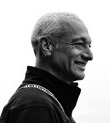A first encounter with Yisrael K. Feldsott’s paintings will leave you with an overwhelming sense of their immediate and intense physicality. The images are raw, brute, unadorned, reduced to essential shape and implied volume. The textures are thick, laden not only with paint but with a freight of substances ranging from human and plant material to metallic media, ground glass and sand, hand-ground paints, and various other elements. Here, they glint and glitter; there, they puddle, drip, grow encrusted and crack open, as though to simulate the ancient creation of the Earth’s crust. The figures—animal or human—can make your hair stand on end: they gaze out at us with unseeing and yet penetrating eyes that seem to know us to the core, calling out to some fundamental part of who we are as fellow beings on this planet; they confront us—as in Original Mother (2008)—with their naked sexuality, as if to stress their role as procreators in the great chain of being; they stand, they squat, they lie prone before us—male and female, sometimes androgynous—and speak directly to the deepest and most secret part of our humanity.
That these supercharged paintings bring something new, brash, vital and exciting into the generally self-conscious, sometimes even precious realm of contemporary American art should not surprise us. They ask us, urgently, to reconsider the role of the metaphysical in our lives and art in a graver, more demanding way than much of the fluff that is today passed off as “spiritual,” and to which they offer a much-needed antidote.
Their intense, intensely conveyed physicality is fitting, since our apprehension of the physical world is the necessary vehicle for our apprehension of the metaphysical, which is surely the experience at the heart of these paintings. They engage us in their process of discovery, of revelation, of making manifest, and ultimately of transformation. It’s a process, in other words, as much akin to alchemy as to the purely aesthetic activity of making a painting. This is perhaps the essence of what has come to be known as “magical realism.”
It’s a necessary starting point, I believe, to observe that Feldsott’s work as an artist is of a piece with his alter identity as a practicing shaman. It is well not to take that commonly misused word lightly, in his case, as is done too often in a society that habitually mistakes the attractively-packaged fake for the real thing. Feldsott came by his “day job” the hard way. He underwent years of initiation and training in the rain forests of the Amazon, relearning at first hand the wisdom that our modern world casually discarded on the path to “progress”—a wisdom that by centuries precedes our Western way of separating the physical from the metaphysical realms as it does man from nature, and instead sees the human heart beating in harmony with the cosmos. Healing, in this other, older way of looking at the world, is a practical matter of recognizing what is out of order in the nature of things, and knowing how to set it right by doing what’s needed to readjust the misplaced balances and energies.
These observations might seem like a strange point of departure for the exhibition catalogue for an artist whose work just as rightfully belongs in the socially hallowed context of the twenty-first century art gallery. I believe, however, that if we want to get past the complex surfaces of Feldsott’s art to its real depth, we cannot do so without taking into account this companion aspect of his life: it is the well-spring of both his process and his vision as a painter.
A conventional critical analysis alone would do little justice to the unique quality of his paintings; and for this reason it may be helpful, first, to walk a while in the artist’s shoes if we are fully to appreciate the origin and power of the work. We must not only be prepared to take the journey the paintings require of us, but also, with their guidance, to venture into the darker shadows of our own hearts and souls—as the artist has done. His work asks us to do no less.
Born in 1954, Feldsott was brought up in rather more worldly circumstances than those to which his journey would eventually lead him: the urban cityscape of Chicago.
Dropping out, first from high school and then from the Art Institute of Chicago, he was lured west by Northern California artists, notably William T. Wiley and Roy de Forest. He enrolled at the California College of Arts & Crafts in Oakland in 1971, embarking initially on a bachelor’s degree.
Recognized as precociously gifted by faculty, however, he was encouraged to move ahead shortly to the Master’s program, where he found himself in the peculiar position of working as an instructor to students both older and more conventionally educated than himself. His large, un-stretched canvases of that time Hunt Hunt Kill Kill (1972, from the Hunter Series) already had the shamanic look of ancient cave works painted on the hides of animals.
What could have been the start of a more conventional career, though, was derailed abruptly soon after it began. In 1979, filled with youthful rage toward a society he saw falling apart about him, a culture he deemed broken and misguided, and a planet—yes, even then it was already
evident—headed toward eventual destruction at the hands of our own human species, the artist was invited in 1978 to present a solo show at a San Francisco gallery. He mounted an exhibition of work whose blunt anger and unrestrained animosity was met with equal anger and hostility. In response, he reverted to a by now familiar pattern: he “dropped out.”
Plunging into a multi-year exile from the gallery scene—in part in the Dante-esque underbelly of Bay Area street life—Feldsott continued throughout this long personal ordeal to produce paintings he describes in retrospect as “dark cityscapes” replete with labyrinthine subways and dark, paranoid imagery—work that did not, for fairly obvious reasons, get shown.
It was a book of Japanese poetry, picked up at random in a bookshop that finally engaged him on a new path. A seemingly chance encounter, it was one of those life-changing epiphanies that Feldsott subsequently learned to pay heed to—a lesson that continues to inform his painting
process to this day. It’s rooted in a curiosity that rejects every first and easy answer: reading those poems, he recalls, he recognized immediately that “these people knew something that I needed to know.”
Enthralled, he abandoned the cul-de-sac he seemed to have reached in his life and embarked at once on what might be described as a vision quest, driving out into a remote part of the Nevada desert for a five-day battle with the demons that had been driving him; and, with a fresh sense of
purpose, set off on a cross-country quest to find those people who knew the “something” that he needed to know. He found it, preliminarily, in the practice of martial arts.
The short version of the artist’s journey from then and there to here and now involved his response to more epiphanies: the decision to accompany a friend on an ecological project in the Mexican heartland; the encounter with a tribal elder, and the latter’s injunction to “go south”; the discovery of a powerful mission and the time spent in the rain forests of the Amazon; the return to Northern California, where he now lives, and the establishment of a widely-known and widely respected practice. In each case, some inner wisdom led him to heed, and follow the call.
It was all, he acknowledges, a part of the process he needed in order to learn “to be with the expression of rage and hostility, to sit in equanimity with defeat and failure, and to transform them into empowerment and compassion.” (Could there, I pause to wonder, be a more apt description of his paintings?)
This is not the story of a mainstream artist, nor, be it said, are Feldsott’s paintings of the mainstream. They are, as I see it, exceptional in a culture where mainstream has become the merely acceptable norm, producing vast amounts of school-trained, acceptable art. Feldsott’s work takes us back to the origins of art itself, and in doing so shows us a way forward, if we are prepared to look and listen.
It is impossible to look at these paintingswithout being taken by their urgency. Feldsott lays no claim to authorship,however, describing them rather as “what ispainted through me.” Out on a walk in thenatural environment, he says, “I seesomething, I hear something, I bear witness, and carry all that back to the studio. The paintings begin to emerge.”
He describes his own role, cheerfully, as that of the “pizza delivery boy.” What is evident, as we look at the paintings, is the process of discovery that goes into their making. Each painting is in itself an adventure, leading us along a multitude of byways and into hidden depths, revealing
sudden, unexpected insights and plunging us just as suddenly back into opacity and
mystery.
Along the way, we are bound to recognize echoes of the voices of precursors, from the ancients who communicated with the spirit world on their cave walls, to the signs and symbols we have inherited from early civilizations and religions, to modernists and contemporaries: impossible not to think, for example, of Picasso, Dubuffet, Miro, Paul Klee; and, more recently, of great artists like Leon Golub who have been unafraid to confront uncomfortable issues in work that is not, primarily, comforting or pleasing to the eye.
As I suggested earlier, Feldsott’s paintings are unsparing in their demands upon the viewer, asking us to look unflinchingly at some of the inevitable, grim facts of existence from which we might prefer to avert our eyes—particularly, in paintings like Soldier With Collateral Damage (2008)
and The Terrorist (2007), from human pain and cruelty reflected in our obsession with violence and war.
He willingly—no, exuberantly—explores the most fundamental and universally shared experience of all living beings: the journey through birth, suffering and death. Among his most powerful paintings are those that evoke the human body’s solemn, ritual transportation to the afterlife.
River (2011), for example, evokes the painter’s grief upon his father’s death. His deeply-felt, compassionate connection with the animal world is expressed in recurrent images of birds and beasts, presented not as fabulous, anthropomorphic stand-ins for deluded human aspirations or behavior, but as creatures with an exemplary nobility of their own, separate from and in some ways perhaps superior to ours.
Lost Trust and Broken Heart at the Altar of the White Wolf (2009) is a memorial to the animal Feldsott befriended and took care of for many years. Cro (2011) is an impassioned celebration of the dark power of the bird we associate with augury and death.
There is something in our human nature that prefers to be offered solace rather than challenge, reassuring confirmation of our beliefs and habits rather than unsettling confrontation. It’s my personal conviction that our aversion to the harsher truths of life—and death!—has been costly to our culture.
We are easily seduced by the pleasures of entertainment, whether lowbrow escapism in the theater or the froth of frankly elitist intellectual byplay in the highbrow art galleries. And we forget the need to examine our own lives, if we are to live them fully. It is refreshing, in this cultural climate, to come upon an artist whose work engages heart and soul as rigorously as Feldsott’s. To spend time with his paintings puts me in mind of that memorable last line of Rainer Maria Rilke’s poem, “Archaic Torso of Apollo”: Du musst dein Leben aendern.
You must change your life. Always. And continuously. It’s a matter of life and death.
— Peter Clothier, 2011
Matter of Life and Death
-
 DETAILS
DETAILSAfter the Fall, 2011
66 x 72 inches (167.64 x 182.88 cm) -
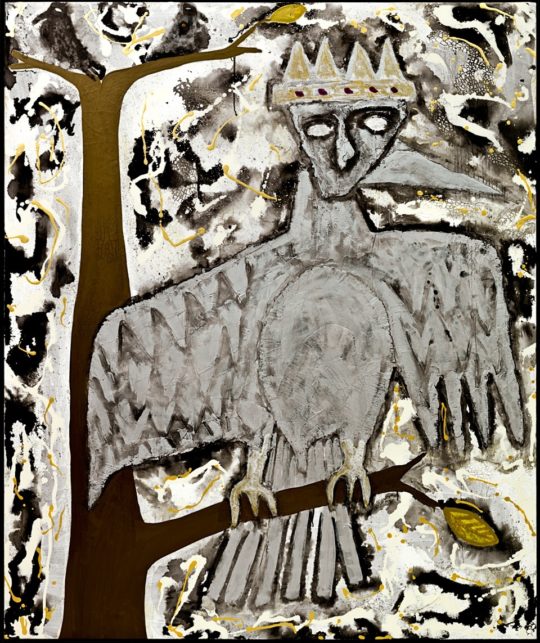 DETAILS
DETAILSAn Angel Called Faith, 2011
66 x 72 inches (167.64 x 182.88 cm) -
 DETAILS
DETAILSArrivals in the Time Before Time, 2000
144 x 120 inches (365.76 x 304.8 cm) -
 DETAILS
DETAILSBirdstone and the Seed of Happiness, 2003
32 x 40 inches (81.28 x 101.6 cm) -
 DETAILS
DETAILSColombia, 2002
32 x 40 inches (81.28 x 101.6 cm) -
 DETAILS
DETAILSCreatures of the Garden, 2001
32 x 40 inches (81.28 x 101.6 cm) -
 DETAILS
DETAILSCro, 2011
40 x 32 inches (101.6 x 81.28 cm) -
 DETAILS
DETAILSDark Water River Guides, 2011
84 x 72 inches (213.36 x 182.88 cm) -
 DETAILS
DETAILSFire on the Mountain, 2008
32 x 40 inches (81.28 x 101.6 cm) -
 DETAILS
DETAILSGhosts of My Ancestors, 2011
42 x 80 inches (106.68 x 203.2 cm) -
 DETAILS
DETAILSGuantanamo Camp X-Ray, 2002
32 x 40 inches (81.28 x 101.6 cm) -
 DETAILS
DETAILSHunt Hunt Kill Kill, 1972
42 x 36 inches (106.68 x 91.44 cm) -
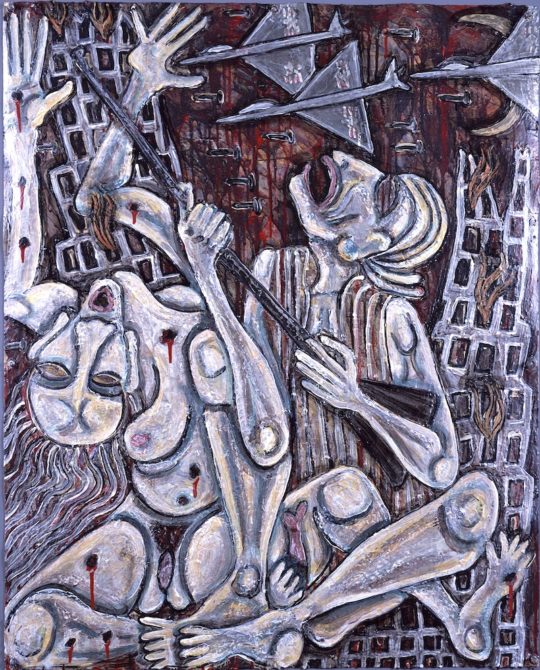 DETAILS
DETAILSLiberation of Woman, 2002
32 x 40 inches (81.28 x 101.6 cm) -
 DETAILS
DETAILSLost Trust and Broken Heart at the Altar of the White Wolf, 2009
72 x 84 inches (182.88 x 213.36 cm) -
 DETAILS
DETAILSMantra of Protection, 2002
32 x 40 inches (81.28 x 101.6 cm) -
 DETAILS
DETAILSMaster of Game, 2002
32 x 40 inches (81.28 x 101.6 cm) -
 DETAILS
DETAILSMaster of Game, the Law and the Hunted, 2000
126 x 120 inches (320.04 x 304.8 cm) -
 DETAILS
DETAILSMessenger of the Coming Storm, 2008
32 x 40 inches (81.28 x 101.6 cm) -
 DETAILS
DETAILSOriginal Song of the Mother, 2008
80 x 54 inches (203.2 x 137.16 cm) -
 DETAILS
DETAILSPrayers to My Fathers, 2001
32 x 40 inches (81.28 x 101.6 cm) -
 DETAILS
DETAILSRegeneration of the Spring and the Pachamama, 2003
32 x 40 inches (81.28 x 101.6 cm) -
 DETAILS
DETAILSRiver, 2011
108 x 73 inches (274.32 x 185.42 cm) -
 DETAILS
DETAILSSeptember’s Children, 2001
32 x 40 inches (81.28 x 101.6 cm) -
 DETAILS
DETAILSSongs of War, 2000
128 x 120 inches (325.12 x 304.8 cm) -
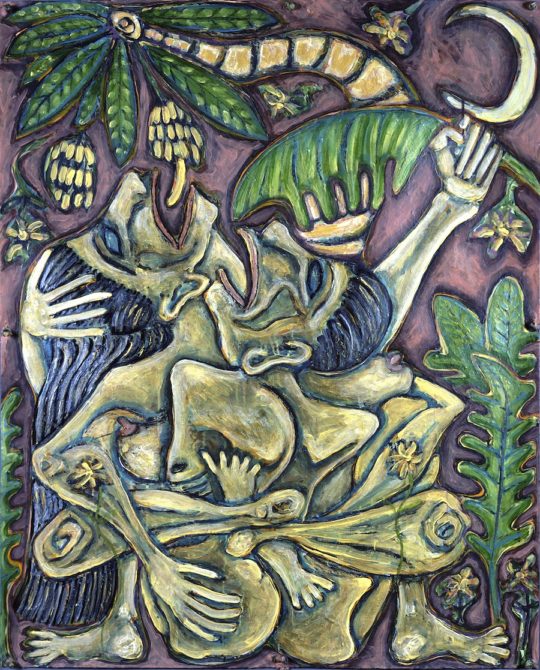 DETAILS
DETAILSSpringtime of Renewal, 2002
32 x 40 inches (81.28 x 101.6 cm) -
 DETAILS
DETAILSThe Angel Who Has Fallen, 2001
32 x 40 inches (81.28 x 101.6 cm)
-
 DETAILS
DETAILSAfter the Fall, 2011
66 x 72 inches (167.64 x 182.88 cm) -
 DETAILS
DETAILSAn Angel Called Faith, 2011
66 x 72 inches (167.64 x 182.88 cm) -
 DETAILS
DETAILSArrivals in the Time Before Time, 2000
144 x 120 inches (365.76 x 304.8 cm) -
 DETAILS
DETAILSBirdstone and the Seed of Happiness, 2003
32 x 40 inches (81.28 x 101.6 cm) -
 DETAILS
DETAILSColombia, 2002
32 x 40 inches (81.28 x 101.6 cm) -
 DETAILS
DETAILSCreatures of the Garden, 2001
32 x 40 inches (81.28 x 101.6 cm) -
 DETAILS
DETAILSCro, 2011
40 x 32 inches (101.6 x 81.28 cm) -
 DETAILS
DETAILSDark Water River Guides, 2011
84 x 72 inches (213.36 x 182.88 cm) -
 DETAILS
DETAILSFire on the Mountain, 2008
32 x 40 inches (81.28 x 101.6 cm) -
 DETAILS
DETAILSGhosts of My Ancestors, 2011
42 x 80 inches (106.68 x 203.2 cm) -
 DETAILS
DETAILSGuantanamo Camp X-Ray, 2002
32 x 40 inches (81.28 x 101.6 cm) -
 DETAILS
DETAILSHunt Hunt Kill Kill, 1972
42 x 36 inches (106.68 x 91.44 cm) -
 DETAILS
DETAILSLiberation of Woman, 2002
32 x 40 inches (81.28 x 101.6 cm) -
 DETAILS
DETAILSLost Trust and Broken Heart at the Altar of the White Wolf, 2009
72 x 84 inches (182.88 x 213.36 cm) -
 DETAILS
DETAILSMan and Bird, 2001
32 x 40 inches (81.28 x 101.6 cm) -
 DETAILS
DETAILSMantra of Protection, 2002
32 x 40 inches (81.28 x 101.6 cm) -
 DETAILS
DETAILSMaster of Game, 2002
32 x 40 inches (81.28 x 101.6 cm) -
 DETAILS
DETAILSMaster of Game, the Law and the Hunted, 2000
126 x 120 inches (320.04 x 304.8 cm) -
 DETAILS
DETAILSMessenger of the Coming Storm, 2008
32 x 40 inches (81.28 x 101.6 cm) -
 DETAILS
DETAILSOriginal Song of the Mother, 2008
80 x 54 inches (203.2 x 137.16 cm) -
 DETAILS
DETAILSPrayers to My Fathers, 2001
32 x 40 inches (81.28 x 101.6 cm) -
 DETAILS
DETAILSRegeneration of the Spring and the Pachamama, 2003
32 x 40 inches (81.28 x 101.6 cm) -
 DETAILS
DETAILSRiver, 2011
108 x 73 inches (274.32 x 185.42 cm) -
 DETAILS
DETAILSSeptember’s Children, 2001
32 x 40 inches (81.28 x 101.6 cm) -
 DETAILS
DETAILSSoldier with Collateral Damage, 2008
32 x 40 inches (81.28 x 101.6 cm) -
 DETAILS
DETAILSSongs of War, 2000
128 x 120 inches (325.12 x 304.8 cm) -
 DETAILS
DETAILSSpirit Brothers from the Invisible World, 2003
32 x 40 inches (81.28 x 101.6 cm) -
 DETAILS
DETAILSSpringtime of Renewal, 2002
32 x 40 inches (81.28 x 101.6 cm) -
 DETAILS
DETAILSTank, 2006
72 x 60 inches (182.88 x 152.4 cm) -
 DETAILS
DETAILSThe Angel Who Has Fallen, 2001
32 x 40 inches (81.28 x 101.6 cm) -
 DETAILS
DETAILSThe Terrorist, 2006
72 x 84 inches (182.88 x 213.36 cm) -
 DETAILS
DETAILSThe Winter of Love, 2002
32 x 40 inches (81.28 x 101.6 cm) -
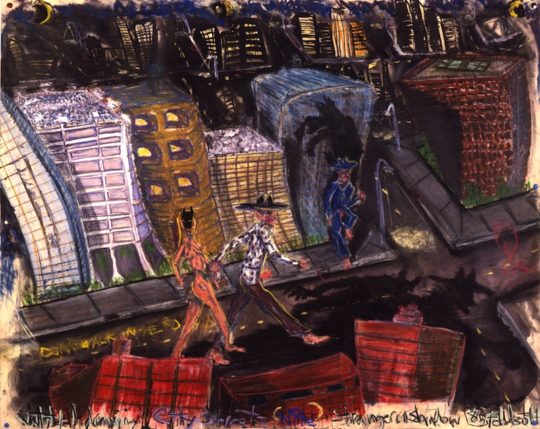 DETAILS
DETAILSUntitled Drawing with City Streets, 1986
42 x 36 inches (106.68 x 91.44 cm) -
 DETAILS
DETAILSUntitled Painting with Bird, 2001
32 x 40 inches (81.28 x 101.6 cm) -
 DETAILS
DETAILSUntitled Painting with Bird, No.2, 2001
32 x 40 inches (81.28 x 101.6 cm) -
 DETAILS
DETAILSUntitled Painting with Blue Bird, 2008
32 x 40 inches (81.28 x 101.6 cm) -
 DETAILS
DETAILSUntitled Painting with Crow, 2008
32 x 40 inches (81.28 x 101.6 cm) -
 DETAILS
DETAILSUntitled Painting with Soldier and Airplane, 2008
40 x 32 inches (101.6 x 81.28 cm) -
 DETAILS
DETAILSWheels of Democracy, 2006
144 x 80 inches (365.76 x 203.2 cm)
No Press releases found.
No News found.
No Events Found.
